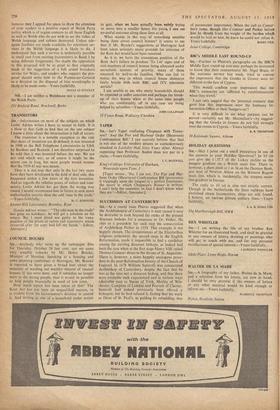SUCCESSION AT CANTERBURY SIR,—In a recent issue Pharos suggested that
when the Archbishopric of Canterbury is next vacant it may' be desirable to look beyond the ranks of the present diocesan bishops for a successor to Dr. Fisher. He cites as a precedent for such step the consecration of Archbishop Parker in 1559. This example is not happily chosen. The circumstances of the Elizabethan religious settlement, the second stage in the English Reformation, made it impossible to find a candidate among the existing diocesan bishops, as indeed had been the case when at the first stage Henry VIII raised Thomas Cranmer direct to the throne of St. Augustine. There is, however, a more happily analogous prece- dent in the post-Reformation history of the Church of England. In 1678 William Sancroft was consecrated Archbishop of Canterbury, despite the fact that he was at the time not a diocesan bishop, and that there were available such experienced and in various ways admirable men as Sterne of York, Morley of Win- chester, Compton of London and Pearson of Chester. Sancroft had indeed previously been offered a bishopric, but he had refused it, feeling that his work as Dean of St. Paul's, in guiding its rebuilding, was of paramount importance. When the call to Canter- bury came, though like Cranmer and Parker before him he shrank from the weight of the burden 'which would be laid on him, he knew he could not refuse it.
Jesus College, Cambridge






























 Previous page
Previous page